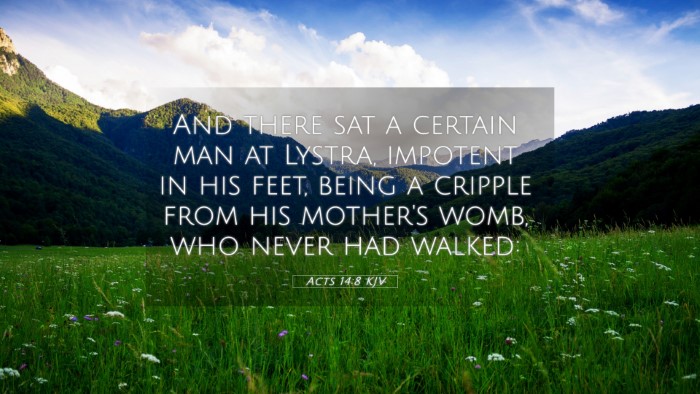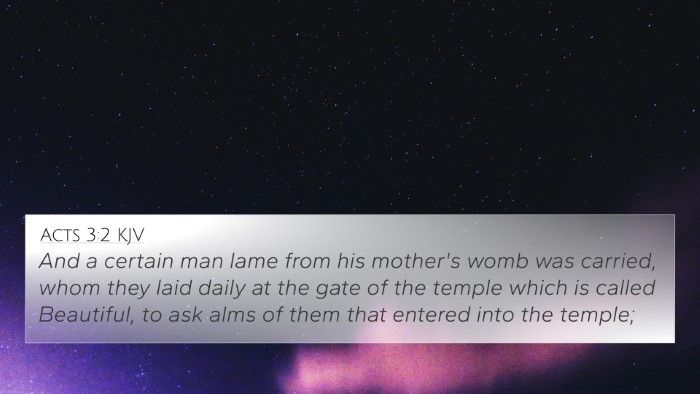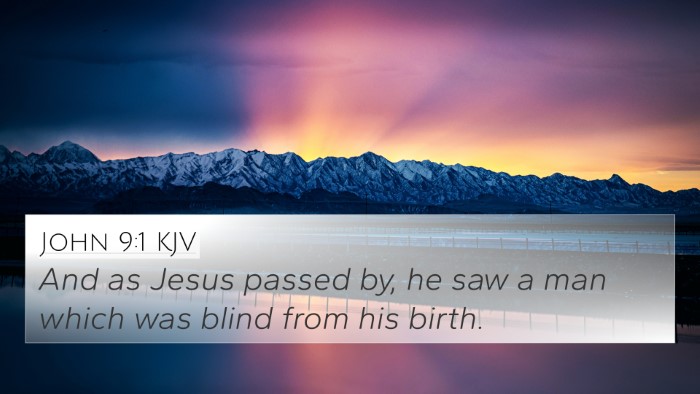Understanding Acts 14:8
Verse: "And there sat a certain man at Lystra, impotent in his feet, being a cripple from his mother's womb, who never had walked."
Summary of Acts 14:8
Acts 14:8 describes a miraculous healing performed by Paul during his missionary journey. The verse highlights a man who had been crippled from birth, emphasizing the extent of his condition as he had never walked. This sets the stage for a divine intervention that showcases God's power through the apostles.
Commentary Insights
- Matthew Henry: Henry notes the significance of the man's condition, stating that his lifelong affliction illustrates the total inability of humans to heal themselves without divine help. This sets a powerful precedent for the transformative work of Christ through His apostles.
- Albert Barnes: Barnes emphasizes the miracle's impact, suggesting that the healing not only demonstrates God's power but also serves as a sign to the people of Lystra. His commentary indicates the man's readiness to receive healing marks a vital aspect of faith in action.
- Adam Clarke: Clarke elaborates on the man’s physical state, indicating that his unique situation serves to magnify the miracle. He also discusses the response of the crowd post-healing, suggesting that witnessing such a miracle can lead to varying interpretations and reactions, often interpreting it through cultural lenses.
Thematic Connections
This verse not only tells of a single event but also poses broader themes in the New Testament, including:
- Faith and Healing: The importance of faith in receiving healing, as seen in many other passages.
- Apostolic Authority: The empowerment given to the apostles to perform miracles, showcasing their role in spreading the Gospel.
- God's Compassion: Illustrating God's desire to reach out and restore those who are broken, both physically and spiritually.
Cross-References
This verse relates to several other passages in the Bible that address themes of healing and faith:
- Acts 3:2-8: Peter heals a lame man at the gate of the temple, echoing the theme of miraculous healing.
- John 5:5-9: Jesus heals a man who was ill for thirty-eight years, emphasizing the power of divine healing.
- James 5:14-15: Instruction for the church to pray for the sick, highlighting the community aspect of healing.
- Mark 16:17-18: Jesus promises that believers will heal the sick, confirming the apostles' authority.
- Matthew 15:30-31: Jesus heals many, demonstrating God's mercy and compassion towards the afflicted.
- Luke 7:22: Jesus speaks of the works He does, which include healing the crippled, thus connecting His ministry with that of the apostles.
- Acts 10:38: Describing how God anointed Jesus with the Holy Spirit and power, who went about healing all who were oppressed.
Importance of Cross-Referencing
Understanding Acts 14:8 in light of other scriptural passages allows for:
- Deepened Insight: Identifying connections between Bible verses enhances comprehension of God's narrative throughout Scripture.
- Comparative Analysis: Engaging in a comparative Bible verse analysis leads to a holistic understanding of theological themes.
- Scriptural Dialogue: Fostering inter-Biblical dialogue heightens the continuity and cohesive nature of biblical texts.
Conclusion
Acts 14:8 stands as a testimony of the mighty works performed by the apostles as they spread the Gospel. The healing of the crippled man not only serves as a miracle but also embodies themes of faith, the work of the apostles, and God's compassion. Through cross-referencing with other scriptures, one can better appreciate the depth and implications of this event in the greater narrative of the New Testament.
SEO Keywords
This commentary provides tools and insights for Bible cross-referencing:
- Tools for Bible cross-referencing
- Bible concordance and cross-reference guide
- How to find cross-references in the Bible for deeper understanding
For further exploration into the connections and thematic Bible verse connections, we invite readers to delve into a comparative study of Scriptures that resonate with Acts 14:8.







